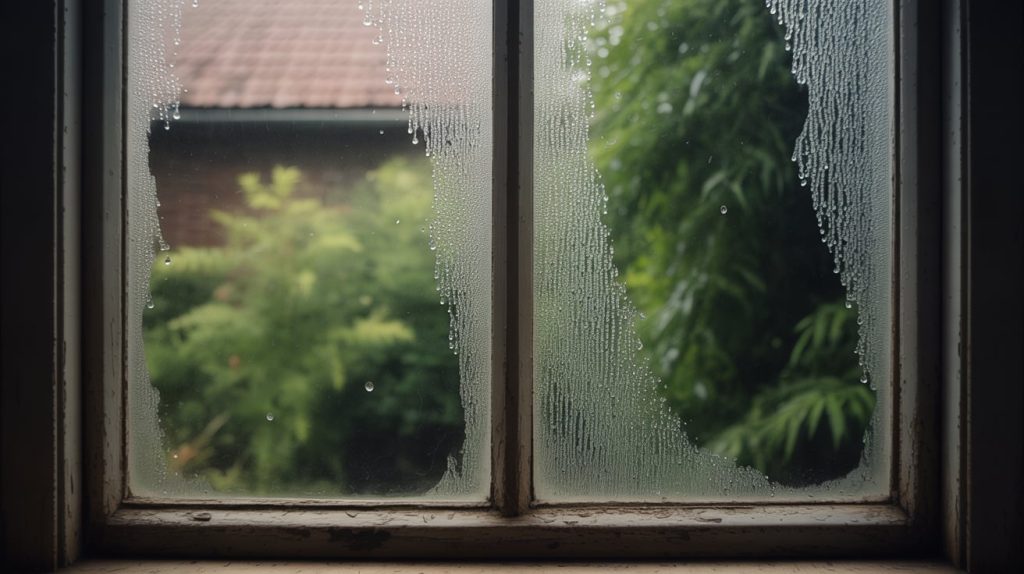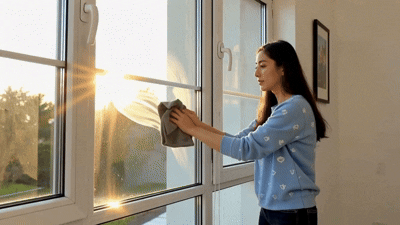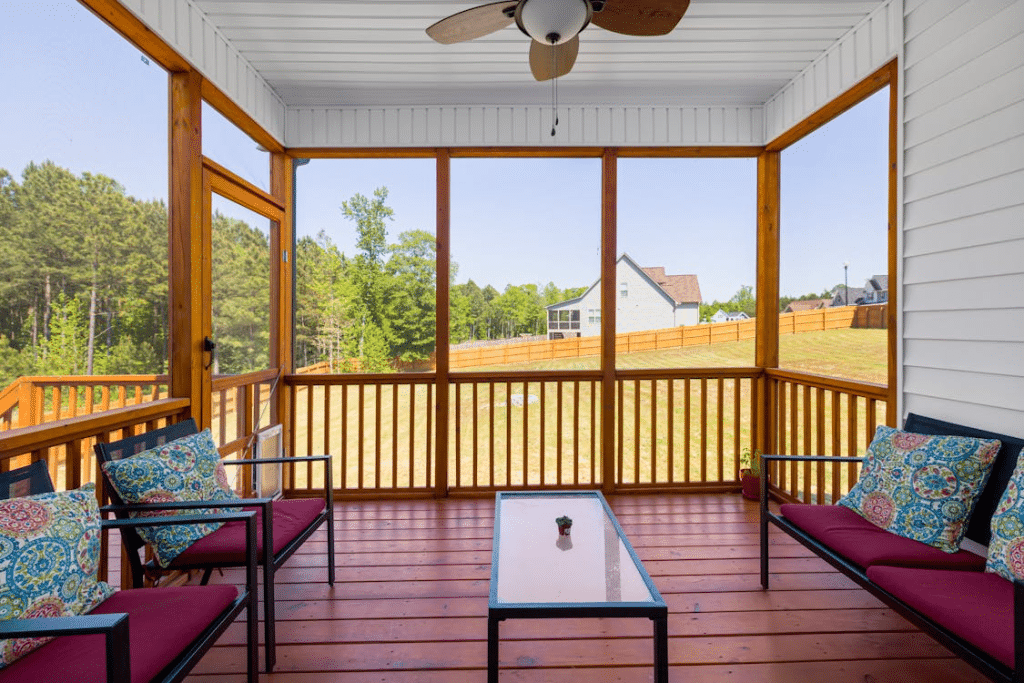Noticed water droplets on your windows? Window condensation is a common headache, especially in colder months.
It starts as a little fog, then turns into puddles on your sills and potentially mold around the frames.
Condensation isn’t just annoying; it can damage your windows and home if left unchecked.
But once you understand what causes condensation on windows, you can fix it for good. Let’s break down why it happens and how to stop it. Time to clear things up.
What is Condensation?
Condensation is when water vapor cools and changes into liquid water.
This occurs when air reaches its dew point, the temperature at which air becomes saturated and can no longer hold moisture as a gas.
Warm air holds more water vapor than cold air. When moist air cools or touches a cold surface, it reaches the dew point and condenses into droplets.
A cold glass shows this perfectly. The glass cools the nearby air below its dew point, causing condensation. The water comes from the air, not the glass.
Clouds form the same way. Rising warm air cools at high altitudes. At the dew point, water vapor condenses around dust particles, creating visible clouds.
Condensation powers Earth’s water cycle.
Water evaporates into vapor, rises and cools, condenses into clouds, then falls as rain or snow.
This process requires water vapor, cooling to the dew point, and usually a surface where water molecules collect. It creates morning dew, foggy windows, clouds, and precipitation, all essential for life on Earth.
Common Causes of Window Condensation
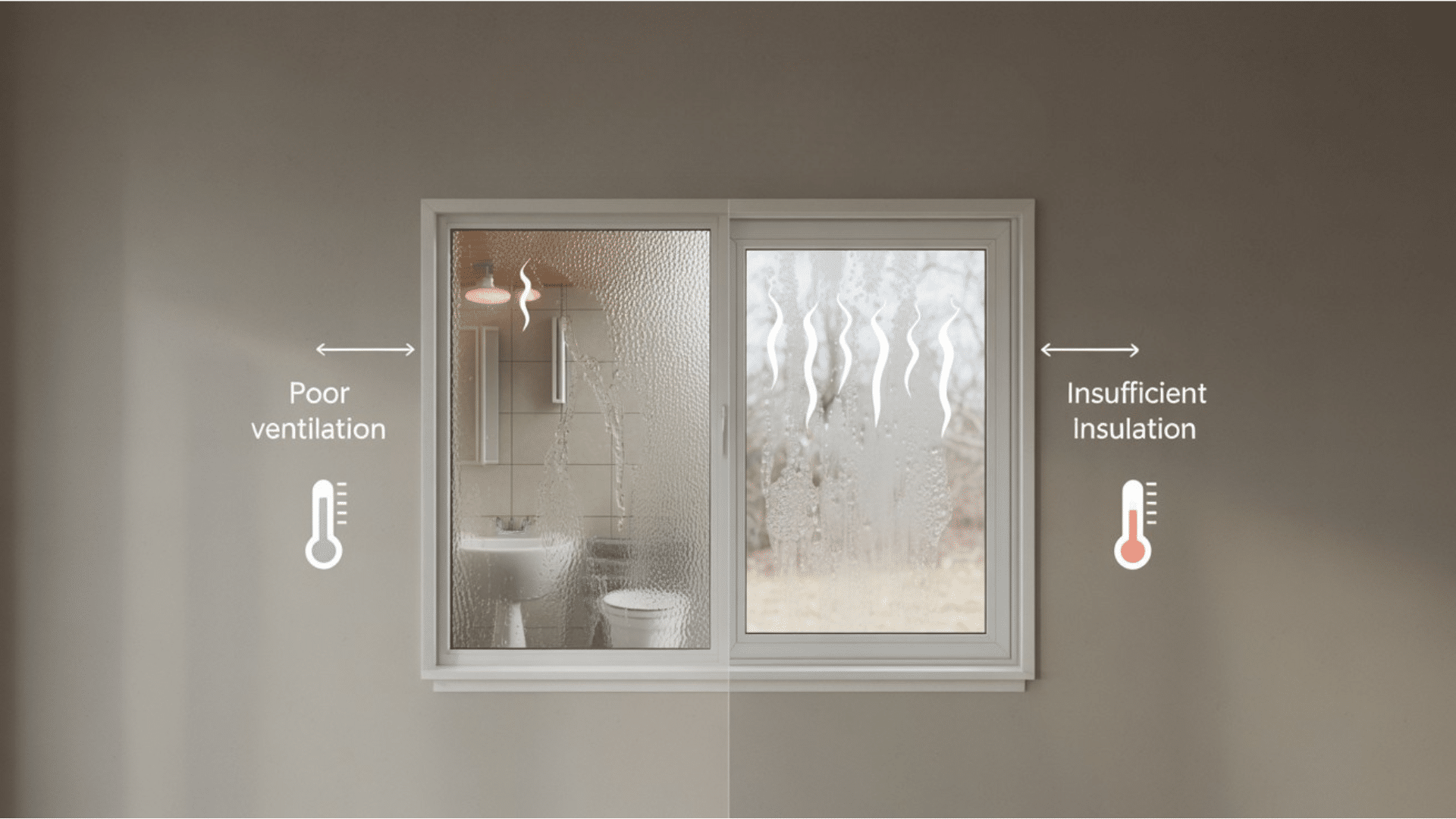
Window condensation forms when warm, moist indoor air meets cold glass surfaces. Understanding what causes condensation on windows helps you tackle it at the source.
1. High Indoor Humidity
Excess moisture in your home is the primary cause. Daily activities like cooking, showering, washing dishes, and even breathing release water vapor into the air.
Without proper ventilation, this humidity accumulates and condenses on cold windows.
Solutions:
- Run exhaust fans during and after cooking or showering
- Use a dehumidifier to maintain 30-50% humidity
2. Temperature Difference
Large temperature gaps between indoor and outdoor air cause condensation.
During winter, cold outdoor temperatures cool window glass significantly. When warm indoor air contacts this cold surface, it drops below the dew point and moisture condenses instantly.
Solutions:
- Upgrade to double or triple-pane windows with Low-E coatings
- Use insulating cellular shades or thermal curtains
3. Poor Ventilation
Inadequate airflow traps humid air indoors. Rooms with closed doors and windows, especially bathrooms and kitchens, accumulate moisture quickly.
Without air circulation or exhaust fans, water vapor has nowhere to go except onto cold surfaces.
Solutions:
- Install exhaust fans that vent outside
- Keep interior doors open for air circulation
4. Single-Pane Windows
Older single-pane windows lack insulation. They transfer outdoor cold directly to the indoor glass surface, making them much colder than double or triple-pane windows.
This creates ideal conditions for condensation.
Solutions:
- Replace with double or triple-pane insulated windows
- Add interior storm windows or window insulation film
5. New, Tight Construction
Modern energy-efficient homes seal air leaks effectively but can trap moisture inside.
Without adequate ventilation systems, humidity builds up and condenses on windows, the coldest surfaces available.
Solutions:
- Install a mechanical ventilation system (HRV or ERV)
- Use a whole-house dehumidifier with the HVAC system
5. Houseplants and Aquariums
Plants release moisture through transpiration, while aquariums constantly evaporate water into the air.
Multiple plants or large fish tanks significantly increase indoor humidity levels.
Solutions:
- Reduce number of houseplants in problem rooms
- Cover aquariums with lids to reduce evaporation
6. Humidifiers
Running humidifiers adds moisture intentionally, but excessive use raises humidity beyond comfortable levels, leading to window condensation.
Understanding these causes helps you control moisture and prevent condensation problems in your home.
Solutions:
- Turn down or off when condensation appears
- Set to maintain 30-40% humidity in winter
Types of Condensation
| Type | Location | Cause | What It Means | Action Needed |
|---|---|---|---|---|
| Interior Condensation | Inside windows | Humid indoor air meets cold glass | High humidity or poor ventilation | Reduce humidity, improve airflow |
| Exterior Condensation | Outside windows | Humid outdoor air meets cool glass | Good window insulation | None, normal and positive |
| Between-Pane Condensation | Between glass panes | Broken seal | Seal failure, lost insulation | Repair or replace window |
| Temporary Condensation | Interior surfaces | Cooking, showering activities | Normal moisture release | Ventilate after activity |
| Chronic Condensation | Interior surfaces daily | Persistent humidity problems | Serious moisture imbalance | Fix ventilation immediately |
When to Worry About Condensation
It’s normal to see a little water or fog on your windows, especially on cold mornings. But sometimes, condensation can be a sign of a problem.
You should worry if:
- The water is between the glass panes. This means the seal is broken, and the window isn’t working right.
- Water drips or pools on the windowsill, which can cause mold or damage.
- You see mold or mildew around the windows, and the air inside is too damp.
- The windows stay foggy all day; your home needs better airflow or less humidity.
It’s okay if:
- It occurs on the outside of your windows, indicating that your windows are doing a good job of keeping the heat in.
- It clears up after a short time inside.
Knowing what causes condensation on windows helps you tell the difference between harmless moisture and signs of deeper ventilation or seal issues.
How to Stop it
Condensation forms when warm, moist air inside your home touches cold windows. To stop it, you need to reduce moisture in the air and keep windows warmer.
1. Let moist air escape
Open windows for a few minutes each day or use kitchen and bathroom fans when cooking or showering. This helps humid air leave your home.
2. Use a dehumidifier
A dehumidifier pulls extra moisture out of the air, making condensation less likely.
3. Improve airflow
Keep vents open and don’t block windows with heavy curtains or furniture. Moving air helps dry surfaces faster.
4. Control humidity
Try to keep indoor humidity between 30% and 50%. You can buy a small humidity meter to check this.
5. Keep windows warm
Close blinds at night, seal gaps around windows, and consider double- or triple-pane glass for better insulation.
Fresh air, less humidity, and warm windows work together to stop condensation and protect your home from mold and dampness.
Seasonal Condensation Patterns
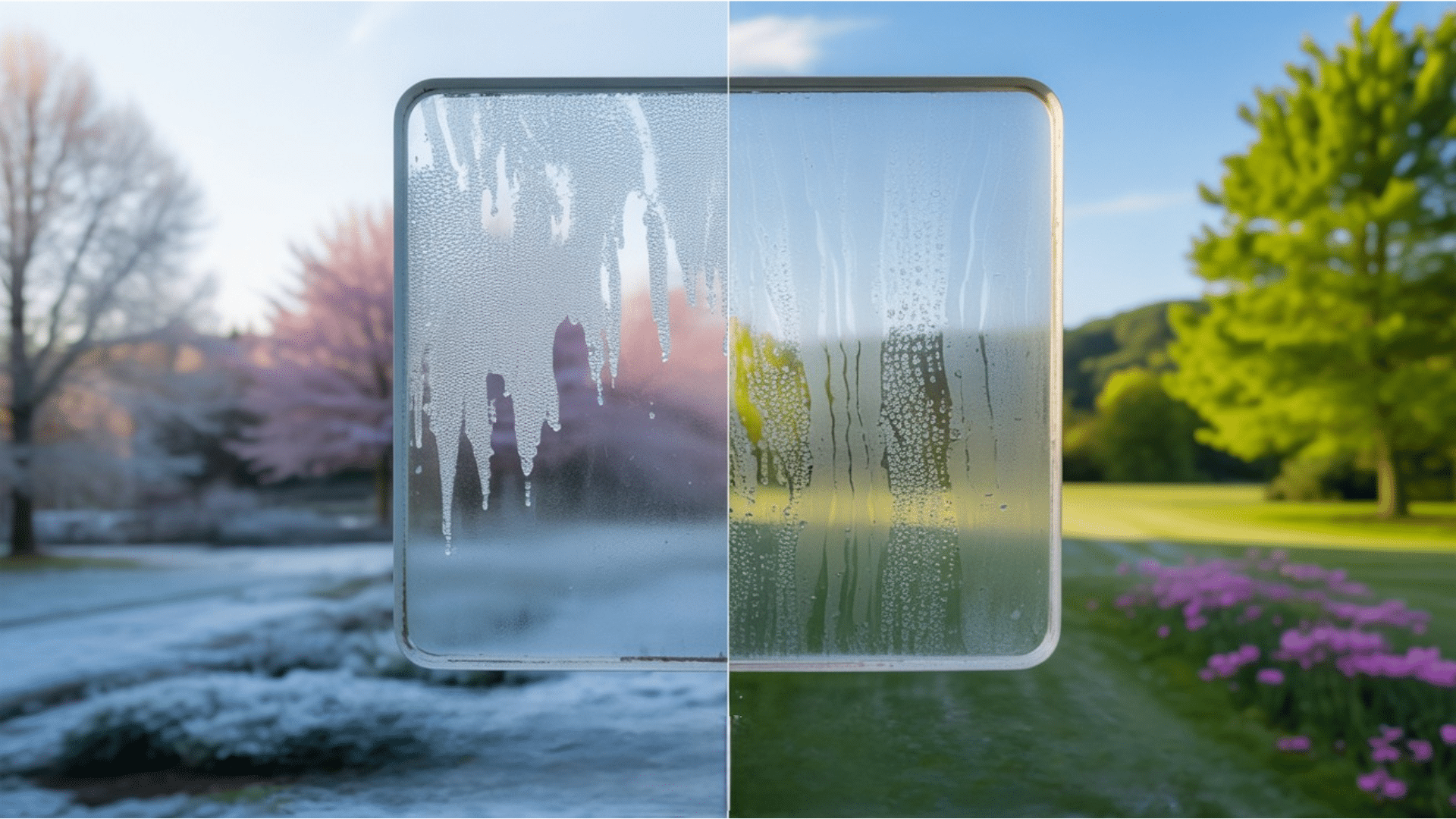
Condensation on windows can change with the seasons because temperature and humidity levels are different throughout the year.
Winter
This is when condensation happens most often. The air inside your home is warm and moist, but the air outside is cold.
When the warm indoor air touches the cold glass, water droplets form.
Fix: Use fans, open windows for short periods, and keep humidity between 30–40%.
Spring and Fall
You may notice some condensation as temperatures go up and down during the day. This is normal and often disappears as the weather balances out.
Fix: Keep air flowing by slightly opening windows or using ceiling fans.
Summer
Condensation is less common inside but can appear on the outside of windows, especially in the morning after a humid night.
Fix: None needed, this means your windows are well-insulated and keeping cool air in.
What Homeowners Are Saying About Window Condensation Problems
Many homeowners notice window condensation, especially during colder months, and share similar frustrations online.
- On forums and social media, people often describe waking up to foggy glass, damp sills, or even mold forming around window frames.
- Some say it’s worse in newer, tightly sealed homes, while others link it to poor airflow or high humidity from everyday activities like cooking, showering, or drying clothes indoors.
- Most find that small changes—like running exhaust fans, cracking a window, or using a dehumidifier- make a big difference in reducing condensation and preventing mold growth.
The Bottom Line
Window condensation doesn’t have to be permanent.
You now know the triggers: high humidity, poor ventilation, and temperature differences. Start with simple fixes like exhaust fans and dehumidifiers. If problems persist, consider upgrading windows or ventilation.
Address both moisture sources and airflow. Monitor humidity levels and adjust seasonally.
Ready for clearer windows? Pick a solution from this blog and start today. Your fog-free windows are just a few steps away.


